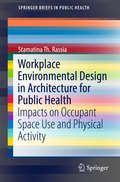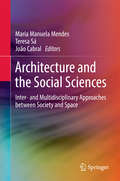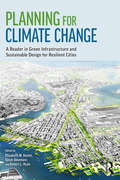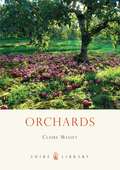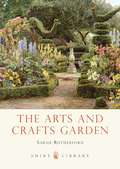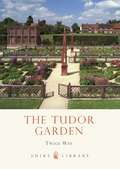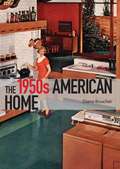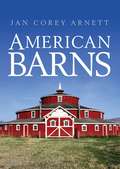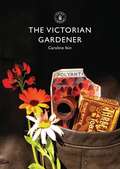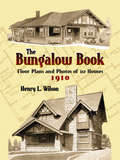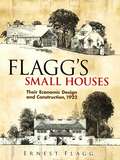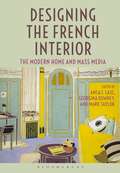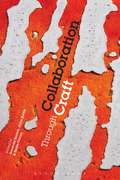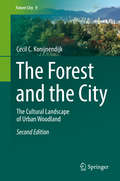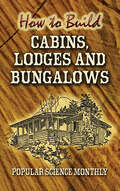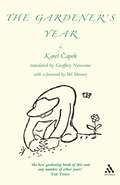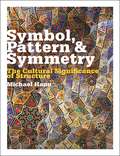- Table View
- List View
Workplace Environmental Design in Architecture for Public Health: Impacts on Occupant Space Use and Physical Activity (SpringerBriefs in Public Health)
by Stamatina Th. RassiaThis concise volume analyzes the potential for the workplace environment—where so many people spend so much of their day—to improve workers’ capacity for health and wellness. It pinpoints the link between sedentary lifestyles and poor health, and explores the role of office spatial design in encouraging physical activity to promote physical activity, health and prevent disease. The featured research study tracks workers’ movement in a variety of office layouts, addressing possible ways movement-friendly design can co-exist with wireless communication, paperless offices, and new corporate concepts of productivity. From these findings, the author’s conclusions extend public health concepts to recognize that influencing population-wide levels of activity through office architectural design alone may be possible. This SpringerBrief is comprised of chapters on : Physical activity and disease: Theory and practice Space-use and the history of the office building Identifying factors of the office architectural design that influence movement, Interdisciplinary research methods in studying worker physical activity, decision-making and office design characteristics The KINESIS model for simulating physical activity in office environmentsThe questions and potential for solutions in Workplace Environmental Design in Architecture for Public Health will interest and inform researchers in interdisciplinary topics of public health and architecture as well as graduate and post-graduate students, architects, economists, managers, businesses as well as health-conscious readers.
Architecture and the Social Sciences: Inter- and Multidisciplinary Approaches between Society and Space
by Maria Manuela Mendes Teresa Sá João CabralThis book contributes to current debates on the relationship between architecture and the social sciences, highlighting current interdisciplinary and transdisciplinary teaching as well as research and practice in architecture and urbanism. It also raises awareness about the complementarities and tensions between the spaces of the project, including the construction spaces and living space. It gives voice to recent projects and socio-territorial interventions, focusing on interdisciplinary and multidisciplinary approaches between society and space. Divided into two parts, the first part discusses the possible dialogue between social sciences and architecture, while the second part explores architecture, politics and social change in urban territories from a European perspective.
Planning for Climate Change: A Reader in Green Infrastructure and Sustainable Design for Resilient Cities
by Elisabeth M. Hamin Infield Yaser Abunnasr Robert L. RyanThis book provides an overview of the large and interdisciplinary literature on the substance and process of urban climate change planning and design, using the most important articles from the last 15 years to engage readers in understanding problems and finding solutions to this increasingly critical issue. The Reader’s particular focus is how the impacts of climate change can be addressed in urban and suburban environments—what actions can be taken, as well as the need for and the process of climate planning. Both reducing greenhouse gas emissions as well as adapting to future climate are explored. Many of the emerging best practices in this field involve improving the green infrastructure of the city and region—providing better on-site stormwater management, more urban greening to address excess heat, zoning for regional patterns of open space and public transportation corridors, and similar actions. These actions may also improve current public health and livability in cities, bringing benefits now and into the future. This Reader is innovative in bringing climate adaptation and green infrastructure together, encouraging a more hopeful perspective on the great challenge of climate change by exploring both the problems of climate change and local solutions.
Orchards (Shire Library #632)
by Claire MassetSome of Britain's surviving orchards are almost six hundred years old, and whether laden with summer fruit or stripped bare by the winter are places of great beauty. Throughout history, they have played an important role in life both rural and urban, providing not just food and drink but also a haven for wildlife and a setting for age-old customs and social gatherings. But when did orchards first appear? What is wassailing and who did it? Why has England lost almost two-thirds of its orchards since 1950 – and what is being done about it today? This beautifully illustrated book reveals the engaging story and rich diversity of Britain's apple, pear and cherry orchards.
The Arts and Crafts Garden (Shire Library)
by Sarah RutherfordThe Arts and Crafts Movement espoused values of simplicity, craftsmanship and beauty quite counter to Victorian and Edwardian industrialism. Though most famous for its architecture, furniture and ornamental work, between the 1890s and the 1930s the movement also produced gardens all over Britain whose designs, redolent of a lost golden era, had worldwide influence. These designs, by luminaries such as Gertrude Jekyll and Sir Edwin Lutyens, were engaging and romantic combinations of manor-house garden formalism and the naive charms of the cottage garden – but from formally clipped topiary to rugged wild borders, nothing was left to chance. Sarah Rutherford here explores the winding paths and meticulously shaped hedges, the gazebos and gateways, the formal terraces and the billowing border plantings that characterised the Arts and Crafts garden, and directs readers and gardeners to where they can visit and be inspired by these beautiful works of art.
The Tudor Garden: 1485–1603 (Shire Library #720)
by Twigs WayContrived, colourful and cultured, the Tudor garden was a paradise on earth, given over to pleasurable pastimes and aesthetic effect. Artificiality was the fashion of the age, with clipped and twining plants vying for space with brightly painted woodwork and patterned beds.Renaissance discoveries reared their heads in royal gardens, where gilded and painted heraldic figures mingled with fantastical sundials and glittering fountains. Walls kept out the wild world beyond, while mounts afforded glimpses to new parklands and provided raised platforms for the banqueting houses of the wealthy. Ever-changing with newly introduced exotic plants, yet featuring year-round knot gardens, the Tudor garden was a vibrant pageant, and is given a suitably colourful celebration in this fully illustrated book.
The 1950s American Home (Shire Library USA)
by Diane BoucherModern living began with the homes of the 1950s. Casting aside the privations of the Second World War, American architects embraced the must-have mod-cons: they wrapped fitted kitchens around fridges, washing machines, dishwashers and electric ovens, gave televisions pride of place in the living room, and built integrated garages for enormous space-age cars. So why was this change so radical? In what ways did life change for people moving into these swanky new homes, and why has the legacy of the 1950s home endured for so long? Diane Boucher answers these questions and more in this colorful introduction to the homes that embody the golden age of modern design.
Glasshouses (Shire Library #747)
by Fiona GrantSince the early seventeenth century, when the cultivation of exotic plants and fruit became fashionable in northern Europe, glasshouses have offered an artificial climate in which they could flourish. At first these structures were within reach only of the very richest, and growing one's own oranges, orchids, pineapples or bananas was a sign of great wealth; but by the mid-nineteenth century manufacturers emerged to cater for a growing middle-class market. Glasshouses became increasingly sophisticated, with different types tailored to house specific crops, and manufacturers competing with one another by developing their own house styles, leading to a wealth of designs endlessly fascinating to the garden or architectural historian. In Glasshouses, Fiona Grant provides an illustrated introduction to the subject, including the twentieth century decline and recent attempts at restoration.
Presidents’ Gardens (Shire Library USA)
by Linda Holden HoytThe White House is the most famous house in the world – yet its 18 acres of perfectly manicured grounds and magnificent gardens, much beloved by the Presidents and their families, are rarely seen by the public. This book is a horticultural celebration of all the Presidents' gardens, beginning with George Washington's beloved Mount Vernon and looking at the development of White House gardens over two centuries. Rare photographs perfectly illustrate highlights from the best of the presidential gardens, including Jackie Kennedy's Rose Garden, the Roosevelt wartime White House greenhouses and Michelle Obama's sustainability-inspired vegetable garden, which now produces food that is served to the First Family. The text is peppered with lively comments and useful tips from gardeners who contributed to White House beautification projects under many different Administrations.
American Barns (Shire Library USA #751)
by Jan Corey ArnettThe heart of every working farm and ranch, the barn is an icon of rural America. This book chronicles – and celebrates – all the main types, and looks at how these treasures of early American architecture developed. It explains how a wealth of immigrant construction methods and range of environments and climates resulted in a fascinating variety of barn styles in the United States, from the earliest rare Dutch examples to simpler English types and others in more surprising shapes (round or even polygonal) crafted by the Shakers in the 1800s. It highlights the most notable, famous and historic barns that the reader can visit, and features the efforts of conservation groups to preserve America's barns and find innovative ways to repurpose these glorious old structures as homes and studios – and as living monuments of rural heritage.
The Victorian Gardener (Shire Library)
by Caroline IkinOver the course of the nineteenth century, gardening came to be considered a respectable profession, providing a means to an education, a good chance of advancement and decent working conditions. The hierarchy of the garden staff became just as regimented as that of domestic servants, and progression was attained by hard work, self-improvement and ambition. Training courses and apprenticeships prepared young gardeners for their trade and horticulture became recognised as a skilled profession, with the head gardener commanding a position of influence and respect and women overcoming social barriers to join their peers on equal terms. This book explores the gardening profession within the complexities of Victorian society and the advances in science and technology that pushed the gardener further into the limelight.
London’s Royal Parks (Shire Library)
by Paul RabbittsLondon's royal parks are amongst its most beautiful and beloved spaces: just as much as the Houses of Parliament, Buckingham Palace and Victoria Station, the mere mention of Hyde or Regent's Park is enough to evoke the capital in all its glory for residents and tourists alike. They have a grand history – some having been royally-owned as far back as the Norman conquest, and others having been acquired by Henry VIII during the Reformation – and since being opened to the public during the eighteenth century have hosted some of London's great events, including the Great Exhibition and innumerable jubilees and celebrations. This book tells the story of all nine of the parks from the point when they were acquired by the monarchy until the present day, including the major historic moments and events with which they are associated.
Icehouses (Shire Library)
by Tim BuxbaumOften hidden away or incorporated into other architectural features, icehouses are a largely forgotten part of our heritage. As winters warmed through the nineteenth century, and supplies of natural ice declined, the development of artificial refrigeration made redundant these curious buildings – often status symbols in themselves – which had been designed to store winter snow and ice into the summer. Icehouses allowed perishables to be preserved, chilled delicacies to be enjoyed, and fevers to be relieved – and on a commercial scale they fed an international trade that carried snow from mountain peaks and ice from frozen lakes to supply the needs of industry, markets and householders. In this illustrated introduction, Tim Buxbaum explains how icehouses developed; how, when and where they were built; and how they operated, including a chapter on icehouses from around the world.
The Edwardian Gardener’s Guide: For All Garden Lovers (Old House Ser.)
by Twigs WayIt is Edwardian England, and a delightful flower garden and fruitful allotment are matters of personal pride, boons for the family dinner table, and even 'important acts of local patriotism'. 'The Edwardian Gardener's Guide' selects nuggets of wisdom from the best-selling 'One & All' garden books, originally published in 1913. In these short booklets, the foremost agricultural and horticultural writers of the period revealed fashions in gardening styles, the best seasonal plants, how to enhance food production and how best to lay out adventurous rockeries, ferneries and grottoes. Packed with charming contemporary advertisements and colour illustrations, this handbook gives a glimpse of the pre-First World War 'golden era' of British gardening. With an introduction by garden historian Twigs Way.
Humphry Repton (Shire Library)
by Laura MayerHumphry Repton (1752–1818) ambitiously styled himself Capability Brown's successor: the century's next great improver of landed property. With his rare combinations of skills – he was a talented topographical sketcher with an excellent knowledge of farming – over thirty years Repton amassed an incredible four hundred commissions, ingratiating himself with the aristocracy and raising the status of his adopted profession. His famous Red Books, illustrated to help clients visualize the potential of their estates, also did their part to encourage the appreciation of landscape aesthetics. With colourful illustrations and detailed site investigations, this book traces Repton's landscape designs from Picturesque wildernesses like Blaise Castle to the progressive Gardenesque style of Wanstead House in Greater London. It is both a perfect visitor's guide to the gardens and an introduction to the theory of Repton's work.
The Bungalow Book: Floor Plans and Photos of 112 Houses, 1910
by Henry L. WilsonCozy, charming, and distinctly Californian, the bungalow is an enduring architectural icon. Originally designed to survive earthquakes, the low, rambling structures combined grace, beauty, and comfort at minimum cost.Early in the twentieth century, Los Angeles architect Henry Wilson, who called himself "The Bungalow Man," compiled 112 of the most popular and economic bungalow blueprints of his time in a catalog for would-be homeowners. Complementing each set of prints was an illustration or photograph of the completed house, which most frequently contained two or three bedrooms with closet space, living and dining rooms, a kitchen with pantry, and a bath.An ideal reference for preservationists and restorers, this reprint of Wilson's rare catalog represents a wonderful time capsule and invaluable guide to a popular style of American domestic architecture.
Flagg's Small Houses: Their Economic Design and Construction, 1922
by Ernest FlaggA celebrated New York architect and designer of the city's fabled Singer Building, Ernest Flagg (1857-1947) was most famous for his skyscrapers. But Flagg was also an ardent proponent of the well-designed single-family dwelling. As this classic treatise illustrates, he devised a variety of structural economies and ingenious innovations.Filled with 526 blueprints, photographs, and other illustrations, Flagg's Small Houses embraces modular designs, the use of ridge-dormers, and saving space, materials, and costs. Flagg offers advice on every corner of the home, from the practicalities of plumbing and heating to the aesthetics of color choices and landscaping designs. Modern designers, both professional and amateur, will find this book a timeless source of advice and inspiration.
Designing the French Interior: The Modern Home and Mass Media
by Anca I. Lasc Georgina Downey Mark TaylorDesigning the French Interior traces France's central role in the development of the modern domestic interior, from the pre-revolutionary period to the 1970s, and addresses the importance of various media, including drawings, prints, pattern books, illustrated magazines, department store catalogs, photographs, guidebooks, and films, in representing and promoting French interior design to a wider audience. Contributors to this original volume identify and historicize the singularity of the modern French domestic interior as a generator of reproducible images, a site for display of both highly crafted and mass-produced objects, and the direct result of widely-circulated imagery in its own right. This important volume enables an invaluable new understanding of the relationship between architecture, interior spaces, material cultures, mass media and modernity.
Collaboration Through Craft
by Amanda Ravetz Alice Kettle Helen FelceyOffering a challenging new argument for the collaborative power of craft, this ground-breaking volume analyses the philosophies, politics and practicalities of collaborative craft work. The book is accessibly organised into four sections covering the cooperation and compromises required by the collaborative process; the potential of recent technological advances for the field of craft; the implications of cross-disciplinary and cross-cultural collaborations for authority and ownership; and the impact of crafted collaborations on the institutions where we work, learn and teach. With cutting-edge essays by established makers and artists such as Allison Smith (US) and Brass Art (UK), curator Lesley Millar, textile designer Trish Belford and distinguished thinker Glenn Adamson, Collaborating Through Craft will be essential reading for students, artists, makers, curators and scholars across a number of fields.
Lofting a Boat: A Step-by-Step Manual (The Adlard Coles Classic Boat series)
by Roger KopanyciaThe second book in our Classic Boat series aimed at traditional boat lovers, builders and restorers.Lofting is an essential stage in the transition between designing andbuilding a boat in order to turn the design plans intoboat lines plans to measure off and build thefull-size boat. Its a tricky art, but this book shows exactly how it is done inclear, step-by-step diagrammatic stages. Aimed specifically at theamateur DIY builder, it will enable anyone to build a boat of any size,whether power or sail. The author has been teaching lofting to boatbuilding students for over10 years, and has found that the key to understanding is visualisation- hence the plethora of step-by-step diagrams in this book to assist the reader to grasp the concepts. Lofting will be welcomed by budding boatbuilders everywhere.
The Forest and the City: The Cultural Landscape of Urban Woodland (Future City #9)
by Cecil C. KonijnendijkAmsterdamse Bos, Bois de Boulognes, Epping Forest, Hong Kong’s country parks, Stanley Park: throughout history cities across the world have developed close relationships with nearby woodland areas. In some cases, cities have even developed – and in some cases are promoting – a distinct ‘forest identity’. This book introduces the rich heritage of these city forests as cultural landscapes, and shows that cities and forests can be mutually beneficial.Essential reading for students and researchers interested in urban sustainability and urban forestry, this book also has much wider appeal. For with city forests playing an increasingly important role in local government sustainability programs, it provides an important reference for those involved in urban planning and decision making, public affairs and administration, and even public health. From providers of livelihoods to healthy recreational environments, and from places of inspiration and learning to a source of conflict, the book presents examples of city forests from around the world. These cases clearly illustrate how the social and cultural development of towns and forests has often gone hand in hand. They also reveal how better understanding of city forests as distinct cultural and social phenomena can help to strengthen synergies both between cities and forests, and between urban society and nature.
How to Build Cabins, Lodges and Bungalows
by Popular Science Monthly"Nothing could be more American than the simple cabin. Not many generations ago, it was the backbone of American life, the headquarters of that important unit, the home. It provided shelter, protection, and a foundation upon which to build a great empire. The pioneer cabin was, in other words, a necessity." -- From the IntroductionOnce regarded as a safe haven and a vital source of security, the little cabin in the country is today more closely associated with leisurely activities -- a vacation spot and even a health investment. First published in the 1930s, this helpful guide was designed to provide vacation home builders with all the information they needed to construct, decorate, and furnish a rustic little cottage. Floor plans and outlines of necessary materials are included, as are tips on constructing foundations, porches, doors, windows, fireplaces, and other structural elements. There are even suggestions for furnishing and beautifying your cabin.A useful how-to manual, offering straightforward advice on the building process from foundation to roof, this practical book can also be enjoyed as an entertaining look at lifestyle elements of the early twentieth century.
The Gardener's Year
by Karel CapekIt is seldom that a practical guide to gardening attains the level of a literary masterpiece, still more seldom that a book on gardening can amuse and instruct even those who have no garden to plant., nor the faintest interest in acquiring one. The Gardener's Year is a charismatic product of Karel Capek's genius: amusing, informative, and full of a quizzical interest in people, animals and plants.In this new version, Geoffrey Newsome -the highly acclaimed translator of Capek's witty Letters from England -has captured the grace and irony of the original Czech, to produce a volume that will be treasured equally by those who love gardening as a relaxation, by those who loathe it as a chore, and by those who have no interest in it whatsoever.
Advances in Design for Inclusion: Proceedings of the AHFE 2018 International Conference on Design for Inclusion, July 21-25, 2018, Loews Sapphire Falls Resort at Universal Studios, Orlando, Florida, USA (Advances in Intelligent Systems and Computing #776)
by Giuseppe Di BucchianicoThis book addresses a range of topics in design, such as universal design, design for all, digital inclusion, universal usability, and accessibility of technologies for people regardless of their age, financial situation, education, geographic location, culture and language. It especially focuses on accessibility for people with auditory, cognitive, neurological, and visual impairments, ageing populations, and mobility for those with special physical needs. The book explores some of the overlaps between inclusive design and web accessibility to help managers, designers, developers, policy makers, and researchers optimize their efforts in these areas. Based on the AHFE 2018 International Conference on Design for Inclusion, held on July 21–25, 2018, in Orlando, Florida, USA, it discusses new design technologies and highlights the disparate needs of the individuals within a community. Thanks to its multidisciplinary approach, it is a valuable resource for readers from various backgrounds, providing them a timely, practice-oriented guide to design for inclusion.
Symbol, Pattern and Symmetry: The Cultural Significance of Structure
by Michael HannSymbol, Pattern and Symmetry: The Cultural Significance of Structure investigates how pattern and symbol has functioned in visual arts, exploring how connections and comparisons in geometrical pattern can be made across different cultures and how the significance of these designs has influenced craft throughout history.The book features illustrative examples of symbol and pattern from a wide range of historical and cultural contexts, from Byzantine, Persian and Assyrian design, to case studies of Japanese and Chinese patterns. Looking at each culture's specific craft style, Hann shows how the visual arts are underpinned with a strict geometric structure, and argues that understanding these underlying structures enables us to classify and compare data from across cultures and historical periods.Richly illustrated with both colour and black and white images, and with clear, original commentary, the book enables students, practitioners, teachers and researchers to explore the historical and cultural significance of symbol and pattern in craft and design, ultimately displaying how a geometrical dialogue in design can be established through history and culture.
